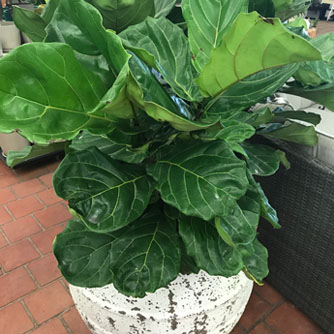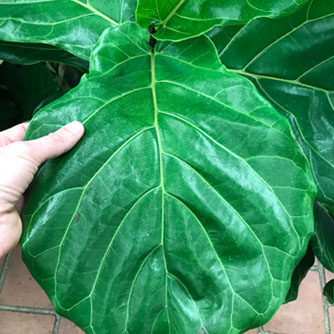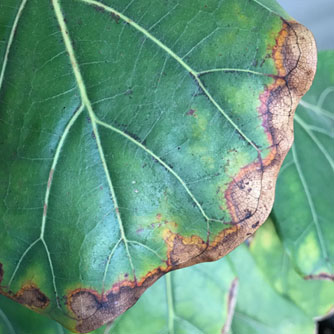Fiddle Leaf Fig
BackFiddle leaf fig (Ficus lyrata) is a popular indoor plant that makes a truly fabulous focal point. It has extremely large leaves shaped like a fiddle (hence its common name) that are covered in prominent veins. Native to tropical regions of Africa it’s a plant that grows well in a pot and thrives on plenty of light and humidity.
The most commonly available type is the straight species, Ficus lyrata, which can grow quite tall. Varieties ‘Compacta’ and ‘ Suncost’ have a more compact habit and are bushier but they aren’t always easy to find.
How To Grow Fiddle Leaf Figs
Fiddle leaf figs will do best in a warm position which receives plenty of bright indirect light. Avoid positions which receive hot afternoon sunlight as their big leaves can burn. Milder morning sunlight is okay. If growing on a balcony they’ll also need protection from winds and the cold. Plants that are kept in low light locations will produce darker green leaves but grow very poorly.
Pot your plant into either a premium or regular potting mix (they’re not fussed as long as the mix has good drainage). Water in with OCP eco-seaweed to help it settle down and reduce transplant shock.
Getting the watering right is important to keep those big leaves looking their best. As a guide water plants when the top of the potting mix has just dried out but avoid leaving the pot sitting in water as this can cause rotting. If being grown in a spot which has very dry air it can help to mist the leaves to boost humidity around the plant which they enjoy.
NOTE: If you are ever tempted to plant a fiddle leaf fig in the ground outside think again. They have aggressive roots and can grow up to 15m high if conditions are right. For most gardens it’s best to keep them contained in a pot!

Fiddle leaf fig makes a great indoor plant
Fertilising and Maintenance of Fiddle Leaf Figs
Fiddle leaf figs can be kept happy with an application of OCP eco-seaweed and OCP eco-aminogro once a month. Increase it to fortnightly if you want faster growth. They don’t like high salt levels which are found in synthetic fertilisers so using eco-seaweed and eco-aminogro is the perfect combination.
As the plant grows you can repot it each spring into a bigger container to accommodate their fast growing roots. Once the plant reaches the maximum pot size you want we recommend a yearly prune of the root ball. Without this their roots will quickly congest and impact on plant vigour.
To root prune simply remove the fiddle leaf fig from the pot and shave off the outer couple of centimetres of roots using sharp secateurs. The larger the root ball the more you can remove. Then repot back into the same pot with fresh potting mix. If the plant is too large or heavy to get out of the pot then dig out several ‘plugs’ of old potting mix and replace with fresh mix. Also remove any roots growing out from the drainage holes at the pot base. Figs usually don’t like this severe root disturbance so water in with eco-seaweed to reduce stress and minimise leaf drop. Give another dose a week later.
Figs which have gotten tall and leggy are best pruned in spring or early summer when plants are actively growing. Cut back to just above an existing bud and apply OCP eco-seaweed and OCP eco-aminogro weekly to get new growth happening quickly. If it’s a multi-stemmed plant only prune 1-2 stems at a time, then wait for some new buds to appear before pruning back other stems. Don’t waste the clippings as they can be used to easily grow new fiddle leaf figs. Simply stick them in a jar of water and wait. After 1-2 months new roots will have developed and you can plant them into small pots. Be sure to water regularly until they fully establish.

The enormous leaves of the fiddle leaf fig
Pests and Diseases of Fiddle Leaf Fig
While these plants are fairly easy to grow there are a few things which can go wrong:
- Leaf drop – occurs when they experience a sudden shock or stress or they simply don’t like their growing conditions. This is a trait of the Ficus family and you’ll need to put on your detective hat to work out what is the underlying cause. Common reasons are the plant is too cold, too wet, too dry, low light levels or not getting enough humidity. Check conditions, work out where the problem lies and adjust accordingly. Remember OCP eco-seaweed can help reduce stress in the plant as well.
- Mealybugs, mites and aphids – spray with OCP eco-oil or OCP eco-neem and ensure you have very good coverage.
- Scale - control this sap sucking pest with sprays of horticultural oil.
- Brown leaves – If the edges of the leaves start to brown and die back then it indicates a lack of water and/or humidity. Soft spots within the leaves or soft brown edges on the other hand can be from over watering and/or poor drainage. Adjust your watering accordingly.

Brown leaf edges due to lack of water


